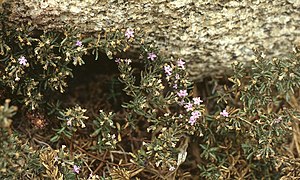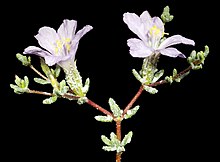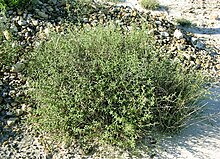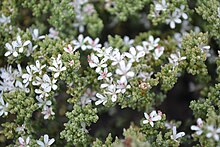Frankenia
| Frankenia | ||||||||||||
|---|---|---|---|---|---|---|---|---|---|---|---|---|

|
||||||||||||
| Systematics | ||||||||||||
|
||||||||||||
| Scientific name of the family | ||||||||||||
| Frankeniaceae | ||||||||||||
| Desv. | ||||||||||||
| Scientific name of the genus | ||||||||||||
| Frankenia | ||||||||||||
| L. |
Frankenia is the only genus of plants ofthe Frankeniaceae family within the order of the carnation-like (Caryophyllales). Germanized they are also called Franconia . The 90 or so species occur in arid areasin warm zones almost worldwide; many species are salt-tolerant.
description




Habit and leaves
Frankenia species grow as small shrubs or perennial or rarely annual herbaceous plants . The sieve tube plastids are of the S type.
Their leaves are arranged opposite one another. The mostly small, scale-shaped (ericoid) or simple leaves can be stalked and are often fused. The leaf margin is smooth. Salt glands are present on the leaves. There are no stipules .
Inflorescences and flowers
The flowers stand alone or in terminal or lateral zymous inflorescences with bracts together.
The mostly hermaphrodite, radial symmetry flowers are four to seven-fold. The long-lasting sepals have grown together to form a folded tube. The mostly free petals are usually long nailed with a scale at the base of the nail. The petals are usually white to pink or, more rarely, red to purple. There are usually two circles with three stamens each, sometimes there are up to 24 stamens. The often flattened stamens are unevenly long and at most briefly fused at their base. The three-cell pollen grains usually have three or six, more rarely two or four apertures and are colpat or rugat. Most three (rarely two or four) carpels have become a top permanent, single-chamber ovary grown. The ovary contains 12 to 100 anatropic, bitegmic, pseudocrassinucellate ovules in parietal placentation . The stylus is mostly branched.
Fruits and seeds
The capsule fruits covered by the calyx spring open into longitudinal flaps and contain many seeds. The small, egg-shaped to cylindrical seeds contain ample starchy endosperm and a straight embryo.
Ingredients and sets of chromosomes
It can cyanidin , ellagic acid and flavonols quercetin and / or kaempferol be present. The basic chromosome number is x = 10, 15.
ecology
Frankenia species are mostly halophytes and xerophytes .
The pollination is effected by insects ( Entomophilie ).
Systematics and distribution
Within the order of the Caryophyllales , Frankeniaceae are most closely related to the Tamaricaceae found in Eurasia and Africa . In the past, both families became the order of the (ex-) Violales Lindl . posed. The Frankeniaceae with Tamaricaceae and Plumbaginaceae with Polygonaceae each form sister groups and these two sister groups together form a clade .
For some authors, three other genera belong to the Frankeniaceae family. They are closely related to the Tamarisk family ( Tamaricaceae ), which, in contrast to this genus / family, have alternate leaves and free sepals.
The first publication of the surname Frankeniaceae, which was valid according to the priority rule, took place in 1817 by Nicaise Auguste Desvaux in Dictionnaire raisonné de botanique , page 188; the publication of Auguste François César Prouvençal de Saint-Hilair was only in 1821 in Samuel Frederick Gray : A Natural Arrangement of British Plants , page 623, 633. The Frankeniaceae family contains only one genus Frankenia . The genus name Frankenia was first published in 1753 by Carl von Linné in Species Plantarum , Volume 1, Page 332. The botanical genus name honors the Swedish botanist Johan Franck (1590–1661), Latinized Frankenius . Type species is Frankenia laevis L. Synonyms for Frankenia L. are: Anthobryum Phil. , Beatsonia Roxb. , Franca Me. ex Adans. , Hypericopsis boiss . , Menetho Raf. , Nothria Mountain. , Streptima Raf. .
The genus Frankenia has an almost worldwide distribution in subtropical to temperate areas. The center of biodiversity is Australia with around 50 species.
Types (selection)






The genus Frankenia L. contains about 90 species (selection):
- Frankenia adpressa Summerh.
- Frankenia ambita Ostenf.
- Frankenia annua Summerh.
- Frankenia boissieri Boiss. : It occurs only in Portugal, Spain, Algeria, Tunisia, Libya and the Canary Islands.
- Frankenia bracteata Turcz.
- Frankenia capitata Webb & Berthel. : It occurs in the Canary Islands and Madeira.
- Frankenia chilensis C. Presl
- Frankenia cinerea A.DC.
- Frankenia conferta Diels
- Frankenia confusa Summerh.
- Frankenia connata Sprague
- Frankenia cordata J.M. Black
- Frankenia corymbosa Desf. : It occurs in Spain, Morocco, Algeria, Tunisia, Libya and on Crete.
- Frankenia crispa J.M. Black
- Frankenia cupularis Summerh.
- Frankenia densa Summerh.
- Frankenia desertorum Summerh.
- Frankenia drummondii Benth.
- Frankenia eremophila Summerh.
- Frankenia ericifolia C.Sm. ex DC. : It occurs only in the Canary Islands.
- Frankenia fecunda Summerh.
- Frankenia foliosa J.M.Black
- Frankenia georgei Diels
- Frankenia glomerata Turcz.
- Hairy Frankenie ( Frankenia hirsuta L. ): It occurs in the Mediterranean area, in Southeast Europe and in the Middle East.
- Frankenia hispidula Summerh.
- Frankenia interioris Ostenf.
- Frankenia johnstonii Correll : It occurs in Texas and in the Mexican states of Nuevo León and Coahuila .
- Frankenia juniperoides (Hieron.) MNCorrea
- Smooth Frankenie ( Frankenia laevis L. ): The three subspecies occur in the Mediterranean, the Azores and Madeira; one of them occurs only in Morocco.
- Frankenia latior Sprague & Summerh.
- Frankenia laxiflora Summerh.
- Frankenia magnifica Summerh.
- Frankenia muscosa J.M.Black
- Frankenia orthotricha (JMBlack) JMBlack
- Frankenia pallida Boiss. & Reut. : It occurs only in Morocco, Algeria and Tunisia.
- Frankenia parvula Turcz.
- Frankenia pauciflora DC.
- Frankenia plicata Melville
- Frankenia pseudoflabellata Summerh.
- Sea heather , also called Dusty Frankenie ( Frankenia pulverulenta L. ): Several subspecies are found in the Chinese provinces of Gansu (only Minqin ), Xinjiang (only in Künes district ) and in western Inner Mongolia (only Ejin Qi ), in Mongolia, Russia , Turkmenistan, in northern and southern Africa, in central and southwest Asia, in southern Europe, on the Azores, Canaries and Madeira. In Australia and the New World she is a neophyte. It grew in the Port of Hamburg from 1890 to 1904 .
- Frankenia punctata Turcz.
- Frankenia salina (Molina) IMJohnst. (Syn .: Frankenia grandifolia Cham. & Schltdl. ): It occurs in California , in northern Mexico and in Chile .
- Frankenia scabra Lindl.
- Frankenia serpyllifolia Lindl.
- Frankenia sessilis Summerh.
- Frankenia setosa W. Fitzg.
- Frankenia stuartii Summerh.
- Frankenia subteres Summerh.
- Frankenia tetrapetala Labill.
- Frankenia thymifolia Desf. : It occurs in Spain, Morocco, Algeria and Tunisia.
- Frankenia triandra J.Rémy (Syn .: Anthobryum triandrum (J.Rémy) Surgis ): It occurs in South America.
- Frankenia uncinata Sprague & Summerh.
swell
- The family of Frankeniaceae in APWebsite . (Sections systematics and description)
- The Frankeniaceae family at DELTA by L. Watson & MJ Dallwitz. (Section description)
- Dennis I. Morris: Frankeniaceae in the Flora of Tasmania Online : PDF, 2009. (Section Description)
- Yasin J. Nasir: Frankeniaceae in the Flora of Pakistan , Volume 7, 1971: Online at Tropicos.org of the Missouri Botanical Garden. (Section description)
- Qiner Yang, Molly Whalen: Frankeniaceae , p. 57 - online with the same text as the printed work , In: Wu Zheng-yi, Peter H. Raven, Deyuan Hong (ed.): Flora of China , Volume 13 - Clusiaceae through Araliaceae , Science Press and Missouri Botanical Garden Press, Beijing and St. Louis, 2007. ISBN 978-1-930723-59-7 (Description and Distribution Sections)
Individual evidence
- ^ Ingrid Schönfelder, Peter Schönfelder : Kosmos Atlas Mediterranean and Canary Islands flora. , Franckh-Kosmos-Verlag Stuttgart 1994, ISBN 3-440-06223-6 . Page 130.
- ^ Carl von Linné: Species Plantarum , Volume 1, 1753, p. 332.
- ↑ Lotte Burkhardt: Directory of eponymous plant names. Extended Edition. Botanic Garden and Botanical Museum Berlin, Free University Berlin Berlin 2018. [1]
- ↑ a b c d Frankeniaceae in the Germplasm Resources Information Network (GRIN), USDA , ARS , National Genetic Resources Program. National Germplasm Resources Laboratory, Beltsville, Maryland.
- ↑ The valid Australian plant names in Australian Plant Name Index = APNI.
- ↑ a b c d e f g h i E. von Raab-Straube (2018): Frankeniaceae. : Data sheet Frankenia In: Euro + Med Plantbase - the information resource for Euro-Mediterranean plant diversity .
- ^ Friedrich WC Mang: List of the wild fern and flowering plants of Hamburg and the surrounding area , in: Naturschutz und Landschaftspflege in Hamburg , 27, 1989, 92.
- ↑ CA Burga, F. Klötzli, G. Grabherr: Gebirge der Erde. Verlag E. Ulmer, Stuttgart, 2004, ISBN 3-8001-4165-5 . Page 462.